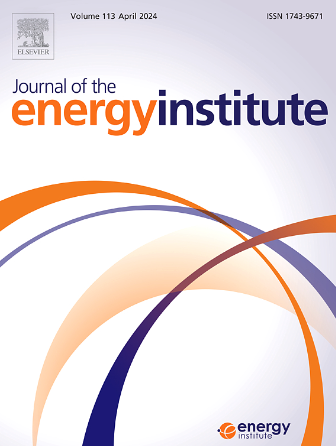二氧化碳-水协同作用使稳定的焦油模型化合物重整在Fe-Cu生物炭催化剂清洁制氢
IF 5.6
2区 工程技术
Q2 ENERGY & FUELS
引用次数: 0
摘要
有效的焦油转化和催化剂稳定性仍然是限制大规模应用生物质气化清洁制氢的关键挑战。本研究以羊粪为前驱物,采用浸渍-热解一体化方法合成了一种低成本、高活性的Fe-Cu双金属生物炭催化剂(SFBC-FeCu)。在N2、10% CO2、10% H2O和10% CO2-5 %H2O气氛下,对催化剂的催化性能和抗失活性能进行了系统评价。结果表明:10% co2 ~ 5% H2O共喂气氛能有效抑制碳沉积,减轻金属颗粒烧结,防止过度氧化引起的失活,并能协同稳定催化剂表面的含氧官能团(OFGs)。通过调节金属位的氧化还原行为,结合晶格氧,不断产生氧空位,建立了良好的电子传递循环,保证了催化剂的稳定高效运行。反应90 min后,该催化剂的甲苯转化率保持在30.56%。相比之下,在单组分气氛(N2、10% CO2、10% H2O)下,由于碳的快速积累、金属位点的烧结或氧化、不稳定的OFGs周转以及活性位点的氢积累,催化剂迅速失活。这些因素共同导致催化性能和稳定性迅速下降。该研究为开发高稳定的生物质气化系统提供了可行的途径和理论依据。本文章由计算机程序翻译,如有差异,请以英文原文为准。
CO2-H2O synergy enables stable tar model compound reforming over Fe–Cu biochar catalyst for clean hydrogen production
Efficient tar conversion and catalyst stability remain key challenges limiting the large-scale application of biomass gasification for clean hydrogen production. In this study, a low-cost and highly active Fe-Cu bimetallic biochar catalyst (SFBC-FeCu) was synthesized using sheep feces as the precursor via an integrated impregnation–pyrolysis method. The catalytic performance and deactivation resistance of the catalyst were systematically evaluated under N2, 10 %CO2, 10 %H2O, and 10 %CO2-5 %H2O atmospheres. The results show that the 10 %CO2-5 %H2O co-feeding atmosphere effectively suppresses carbon deposition, alleviates metal particle sintering, prevents excessive oxidation-induced deactivation, and synergistically stabilizes oxygen-containing functional groups (OFGs) on the catalyst surface. By regulating the redox behavior of metal sites, incorporating lattice oxygen, and continuously generating oxygen vacancies, a favorable electron transfer cycle is established, ensuring the stable and efficient operation of the catalyst. After 90 min of reaction, the catalyst maintained a toluene conversion rate of 30.56 %. In contrast, under single-component atmospheres (N2, 10 %CO2, 10 %H2O), the catalyst deactivated rapidly due to rapid carbon accumulation, metal site sintering or oxidation, unstable OFGs turnover, and hydrogen accumulation on active sites. These factors collectively result in a rapid decline in catalytic performance and stability. This study provides a feasible pathway and theoretical basis for developing highly stable biomass gasification systems.
求助全文
通过发布文献求助,成功后即可免费获取论文全文。
去求助
来源期刊

Journal of The Energy Institute
工程技术-能源与燃料
CiteScore
10.60
自引率
5.30%
发文量
166
审稿时长
16 days
期刊介绍:
The Journal of the Energy Institute provides peer reviewed coverage of original high quality research on energy, engineering and technology.The coverage is broad and the main areas of interest include:
Combustion engineering and associated technologies; process heating; power generation; engines and propulsion; emissions and environmental pollution control; clean coal technologies; carbon abatement technologies
Emissions and environmental pollution control; safety and hazards;
Clean coal technologies; carbon abatement technologies, including carbon capture and storage, CCS;
Petroleum engineering and fuel quality, including storage and transport
Alternative energy sources; biomass utilisation and biomass conversion technologies; energy from waste, incineration and recycling
Energy conversion, energy recovery and energy efficiency; space heating, fuel cells, heat pumps and cooling systems
Energy storage
The journal''s coverage reflects changes in energy technology that result from the transition to more efficient energy production and end use together with reduced carbon emission.
 求助内容:
求助内容: 应助结果提醒方式:
应助结果提醒方式:


